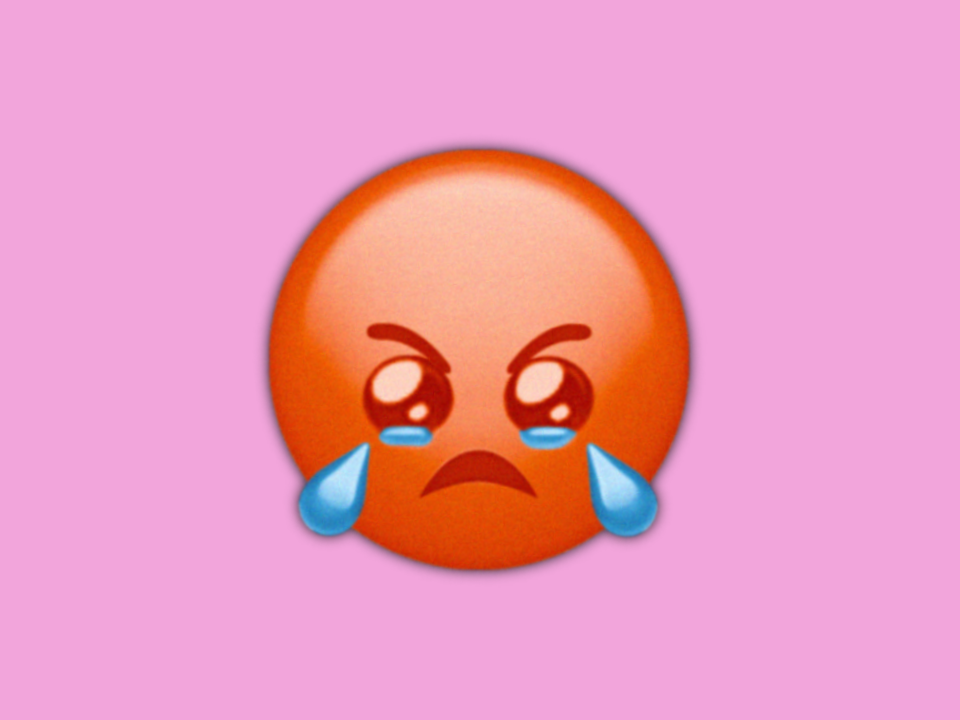Why Can’t I Stop Crying When I’m Angry?
There can be a bunch of other emotions mixed up in these tears.
Ah, crying. Those salty droplets can feel pretty damn cathartic under the right circumstances, like celebrating the life of a loved one who passed, when your little sibling just graduated, or when you see your first heartwarming holiday commercial of the year. (Just me?) But raise your hand if you also tend to cry when you’re feeling emotions that aren’t normally associated with tears, like anger, raging frustration, or when you’re feeling stuck. Yep, the angry cry is very much a thing, and it can feel a little awkward—especially when you’re trying to make a very good point!
Trust me, I get it. I never used to cry when I was upset or angry. I honestly used to get confused and uncomfortable when I’d see people cry when they were experiencing these types of feelings. It felt strange, and I’d wonder, Why are they crying? They’re not even sad? But, things have changed. I’m now someone who cries when I’m pissed or when I feel stuck.
Despite that weirdness, I’m happy to report that it’s completely normal. Here’s why the most annoying type of cry happens and how to get through it when it does.
Why you cry when you’re angry and frustrated
There are a range of emotions that can trigger crying, including fiery rage. And, despite how weird it seems, it can actually be a useful coping tool. That’s partially because, when we cry, there’s often a spike of oxytocin and endogenous opioids in our brain, which can act sort of like natural pain relievers, says clinical psychologist Danielle McGraw, PhD. And the act of crying can force us to slow down, breathe, and bring our heart rate and stress levels back down to their normal levels, says licensed therapist, Anastasia Locklin, LMFT.
Ultimately, “the purpose of emotional crying is for human connection,” Dr. McGraw says, adding that when people reach out to us to help or support us, we often feel better. So it makes sense that when we’re angry or frustrated, which often comes along with a feeling of helplessness, we might cry and hope someone comes along to comfort us, she adds. Shout out to anyone who has ever helped a loved one when they were filled with angry tears!
Speaking of that helpless feeling, the angry and frustrated cry can also mask a bunch of other emotions, like vulnerability, embarrassment, nervousness, sadness, injustice, worry, anxiety, grief, confusion, betrayal, or like someone crossed your boundaries or caught you off guard. All of these feelings can prompt those emotional tears too, even if they’re confused with anger or frustration at the time.
And anger and frustration are often easier to acknowledge than those other (likely more vulnerable) feelings lurking beneath the surface, especially if you weren’t raised or socialized to be open and honest about what’s going on in your mind, Locklin adds.
Heads up: You might not always feel better after an angry cry, especially if nobody comes in with an assist. Ultimately, that could leave you feeling more alone and still angry. Which is another reason why this type of cry sitch seems to suck so bad.
What you can do about the angry cry
As tempting as it might be to avoid crying at all costs, don’t go turning into a robot. We can’t just turn off our feelings, so suppressing them won’t work. Sorry! Instead, acknowledge that you’re feeling some complicated stuff and that it’s OK to cry when you’re feeling this way.
That said, there are obviously times when you might not want to show what’s going on with you in such a visible way. Ahem, like maybe when you’re at work, when you’re trying to have a serious conversation, when you want to appear objective, when you’re uncomfortable with your surroundings, or when you don’t want anyone to take the crying personally.
And, if you’re like me, knowing when you’re going to cry can be a little hit-and-miss. Sometimes you feel the emotions welling up for a while before the tears start flowing, but other times, the tears burst through like the Kool-Aid man without much notice, which can be awkward if you’re in a setting like the ones above. So, here’s exactly how to deal with the angry tears start raging.
Tune into your body.
If your angry cry normally strikes without warning, you may be overlooking some clues that could tip you off next time, Locklin says. An elevated heart rate, sweating, dry mouth, flushed face (even if you don’t ever turn red, you might feel like your face is red or heated), watery eyes, or a stomach that feels like it’s either in knots or like you’re falling—all of these are signals that an angry cry could be on the way
Don’t ignore the tears.
There’s no one-size-fits-all solution, but if the tears are already present, try not to power through and pretend like they’re not. If you do, you could end up inflicting more stress (see: an elevated heart rate) on your body, which can make it even harder to stop crying, Locklin says.
Take a timeout to distract yourself.
If you're angry, frustrated, or experiencing a mix of other underlying feelings, take a break (if you can) to pinpoint what you're upset about and what other emotions might be at work. If you’re around people, there’s no shame in telling them that you need to pause or revisit this topic at a later date. Plus, speaking up can also give the person who brought up (or caused) the issue some reassurance that you’re not being avoidant, you just need some time to process, she adds.
If you need a less obvious way to take a break, try drinking some water. Because drinking water can take you from that fight-or-flight response to more of a rest-and-digest state of mind, it can be an easy, discreet way to calm down, Dr. McGraw adds. You can also try to distract yourself by counting the tiles on the floor or mentally listing a few things you can hear and see.
Move ~mindfully~.
When you’re taking a breather, try some calming techniques, like (literally) deep breathing, taking a walk, getting outside, or checking in with your body to see where you’re holding tension. By the way, moving mindfully also includes being totally still if that makes you feel better, Locklin says.
The bottom line: Crying when you’re feeling angry or frustrated can be (you guessed it!) frustrating. So, the next time you’re in that headspace, see if you can take notice of any of those warning signs and practice ways to process and communicate all the complicated emotions that might be coming up for you. And if you need some extra guidance, therapy is always an option for learning to cope with angry crying.
Wondermind does not provide medical advice, diagnosis, or treatment. Any information published on this website or by this brand is not intended as a replacement for medical advice. Always consult a qualified health or mental health professional with any questions or concerns about your mental health.




